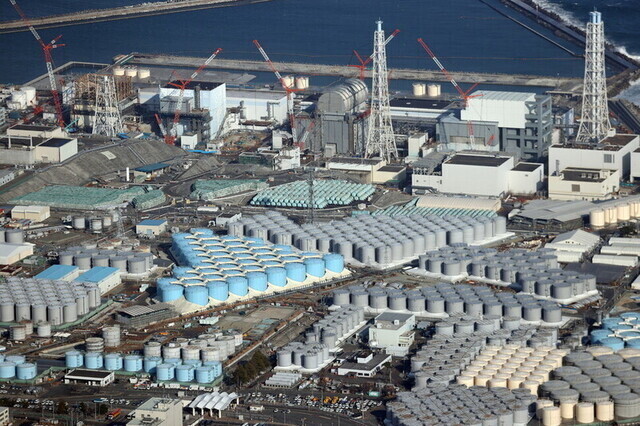hankyoreh
Links to other country sites 다른 나라 사이트 링크
S. Korean experts call Japan’s impact assessment of Fukushima water dumping shortsighted

A Japanese simulation of the impact of radioactive water that it plans to release into the ocean is focused on the short term, and Japan doesn’t have any contingency plans in place for accidents during the release phase, say South Korean experts who attended a working-level briefing organized by Japan and Korea on Friday, the South Korean Ministry of Foreign Affairs reported.
The Japanese government is planning to release contaminated water from the Fukushima Daiichi Nuclear Power Station, where the Fukushima nuclear accident occurred in 2011.
That was part of a summary of a Korea-Japan briefing about a draft report assessing the impact of radiation during the release of contaminated water from the Fukushima plant into the ocean that a Foreign Ministry official provided reporters Tuesday. The draft report was published on Nov. 17 by Tokyo Electric Power Company (TEPCO).
In the Nov. 17 report, TEPCO said the contaminated water stored in tanks at the Fukushima site — which the Japanese government refers to as “processed water” — would have a negligible impact on the marine environment if released into the ocean. TEPCO plans to finalize the report by Dec. 18, after consulting the opinions of stakeholders.
A Foreign Ministry official added that the Japanese had said they’d organized a special working-level briefing for Korea, but not any other countries, “because Korea is Japan’s closest neighbor and the most important stakeholder.”
The Korean experts said they’d used the briefing to ask why Japan has set a yearly radioactivity target of 22 terabecquerels for the tritium that’s not removed by the advanced liquid processing system that Japan is using to process the radioactive water. They also asked why Japan has chosen a region measuring 10 square kilometers for assessing the density of radioactive contamination in seawater.
The Foreign Ministry reported that the Korean experts had also taken issue with the fact that the Japanese simulation didn’t account for long-term factors, including environmental changes in the weather and the ocean, and with the lack of contingency plans for the potential release of water that hasn’t been adequately processed.
Experts did not have enough time to address all related issues during this working-level session, which lasted for two and a half hours, so they plan to send additional questions in writing.
Korea and Japan apparently have yet to reach an agreement about setting up a bilateral deliberative body, as Korea has requested, to discuss the issue of releasing the contaminated water.
“The two sides recognize the need for creating a bilateral deliberative body to exchange information more systematically, but we continue to trade opinions about setting the agenda and choosing the participants for that deliberative body,” the Foreign Ministry official said.
By Kim Ji-eun, staff reporter
Please direct questions or comments to [english@hani.co.kr]

Editorial・opinion
![[Column] Park Geun-hye déjà vu in Yoon Suk-yeol [Column] Park Geun-hye déjà vu in Yoon Suk-yeol](https://flexible.img.hani.co.kr/flexible/normal/500/300/imgdb/original/2024/0424/651713945113788.jpg) [Column] Park Geun-hye déjà vu in Yoon Suk-yeol
[Column] Park Geun-hye déjà vu in Yoon Suk-yeol![[Editorial] New weight of N. Korea’s nuclear threats makes dialogue all the more urgent [Editorial] New weight of N. Korea’s nuclear threats makes dialogue all the more urgent](https://flexible.img.hani.co.kr/flexible/normal/500/300/imgdb/original/2024/0424/7317139454662664.jpg) [Editorial] New weight of N. Korea’s nuclear threats makes dialogue all the more urgent
[Editorial] New weight of N. Korea’s nuclear threats makes dialogue all the more urgent- [Guest essay] The real reason Korea’s new right wants to dub Rhee a founding father
- [Column] ‘Choson’: Is it time we start referring to N. Korea in its own terms?
- [Editorial] Japan’s rewriting of history with Korea has gone too far
- [Column] The president’s questionable capacity for dialogue
- [Column] Are chaebol firms just pizza pies for families to divvy up as they please?
- [Column] Has Korea, too, crossed the Rubicon on China?
- [Correspondent’s column] In Japan’s alliance with US, echoes of its past alliances with UK
- [Editorial] Does Yoon think the Korean public is wrong?
Most viewed articles
- 1‘We must say no’: Seoul defense chief on Korean, USFK involvement in hypothetical Taiwan crisis
- 2N. Korean delegation’s trip to Iran shows how Pyongyang is leveraging ties with Moscow
- 3Amnesty notes ‘erosion’ of freedom of expression in Korea in annual human rights report
- 4[Column] Park Geun-hye déjà vu in Yoon Suk-yeol
- 5‘Weddingflation’ breaks the bank for Korean couples-to-be
- 6[Reportage] On US campuses, student risk arrest as they call for divestment from Israel
- 7[Editorial] New weight of N. Korea’s nuclear threats makes dialogue all the more urgent
- 8Why Korea shouldn’t welcome Japan’s newly beefed up defense cooperation with US
- 9[Guest essay] The real reason Korea’s new right wants to dub Rhee a founding father
- 10Will NewJeans end up collateral damage in internal feud at K-pop juggernaut Hybe?